 A big white balloon floated lazily above midtown Manhattan last week. Tethered to a trailer and hovering 800 feet above the city streets, the balloon—nicknamed “Lucy”—sported high-tech cameras as it bobbed about in urban airspace that is normally restricted for aircraft.
A big white balloon floated lazily above midtown Manhattan last week. Tethered to a trailer and hovering 800 feet above the city streets, the balloon—nicknamed “Lucy”—sported high-tech cameras as it bobbed about in urban airspace that is normally restricted for aircraft.
The balloon shot this skyscraper footage for architects and real-estate developers surveying the area, offering them a unique view of urban architecture. But Curt Westergard, president of the Digital Design and Imaging Service company that designed and launched Lucy, says tethered balloons are good for far more than shooting city vistas. They can also keep watch over borders, track natural disasters such as oil spills, and lots more.
“Balloons provide a simple, long-duration, quiet, aerial platform, which is accepted in cities that have very difficult flight restrictions,” he says.
Building MRI
Gorgeous aerial photography is the attention-grabber, but Lucy doesn’t always carry a camera in its payload. Sometimes, imaging in other parts of the spectrum is more helpful. For example, Westergard has strapped high-resolution infrared scanners to some of his balloons to gather complex data about the energy efficiency of older buildings.
“We’d like to find the most wasteful and the most efficient buildings on the planet, and give them a full-body MRI scan to find out how they are working,” Westergard says.
During the winter, older, inefficient buildings often leak heat from specific locations along their facades or rooftops. Hoisted up to 1400 feet by Westergard’s balloons, thermal infrared cameras can highlight problem spots and help companies save money and energy.
“We want to know what holes should be plugged,” Westergard says. “How many gallons of oil does an inefficient building consume during a cold snap?” Westergard and his team did a lot of the early work without a contact—they just flew over other people’s buildings to see how much they leaked. Now people hire him to do this.
Drone Driving School
As the Federal Aviation Administration starts to certify drones for commercial use, test centres will need reliable ways to prove that unmanned aircraft are safe and reliable. Westergard is now lobbying to bring his balloons to the FAA proving ground. Aerostatic balloons could function as tethered, moving obstacles, capable of changing altitude or position quickly.
“Our aerostat fleet could serve as traffic cones in the sky,” he says, in tests to prove drone safety. “Drone test pilots could navigate around us and, even if they hit us, it’s a lot cheaper than hitting a building or a Predator drone.”
And well-chosen balloon payload could bring even more high-tech challenges to fledgling UAS. Westergard has proposed that his balloons carry a radar reflector into the air in an attempt to deliberately sabotage a drone’s signal to prove whether it’s possible.
“The FAA is concerned that many of these drones are controlled at the same frequency as a garage-door opener,” Westergard says. “We could provide not just a balloon, but a radar jammer.” Once pilots prove that they can navigate through the static and maintain control of their aircraft, drones might be deemed safe enough to fly over residential areas.
“We called the payload Nine-Eye,” Westergard says. “When you pull a remote trigger, nine cameras shoot in a starburst pattern and capture a complete spherical panorama, with no blind spots.”
Although the wreckage of Fossett’s fatal flight didn’t turn up until many months later, the Nine-Eye camera is still in operation. “It works great,” Westergard says. “In fact, that’s what we had flying above New York City the other day.”
